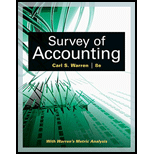
Survey of Accounting (Accounting I)
8th Edition
ISBN: 9781305961883
Author: Carl Warren
Publisher: Cengage Learning
expand_more
expand_more
format_list_bulleted
Concept explainers
Textbook Question
Chapter 12, Problem 12.4.1MBA
Contribution margin per constraint Using the data and your answers from MBA 12-2, determine the following:
The selling price necessary for Laminated glass to be as profitahle as Regular glass.
Expert Solution & Answer
Want to see the full answer?
Check out a sample textbook solution
Students have asked these similar questions
None
Hello tutor solve this question and accounting answer
I am looking for the correct answer to this general accounting question with appropriate explanations.
Chapter 12 Solutions
Survey of Accounting (Accounting I)
Ch. 12 - Mario Company is considering discontinuing a...Ch. 12 - Victor Company is considering disposing of...Ch. 12 - Prob. 3SEQCh. 12 - For which cost concept used in applying (he...Ch. 12 - Prob. 5SEQCh. 12 - Prob. 1CDQCh. 12 - Prob. 2CDQCh. 12 - A company could sell a building for $650,000 or...Ch. 12 - Prob. 4CDQCh. 12 - Prob. 5CDQ
Ch. 12 - A company fabricates a component at a cost of...Ch. 12 - Prob. 7CDQCh. 12 - Prob. 8CDQCh. 12 - Prob. 9CDQCh. 12 - Prob. 10CDQCh. 12 - Prob. 11CDQCh. 12 - Prob. 12CDQCh. 12 - Lease or sell decision Orwell Industries is...Ch. 12 - Prob. 12.2ECh. 12 - Prob. 12.3ECh. 12 - Prob. 12.4ECh. 12 - Prob. 12.5ECh. 12 - Make-or-buy decision Watts Technologies Company...Ch. 12 - Make-or-buy decision Wisconsin Arts of Milwaukee...Ch. 12 - Machine replacement decision Creekside Products...Ch. 12 - Differential analysis report for machine...Ch. 12 - Sell or process further St. Paul Lumber Company...Ch. 12 - Prob. 12.11ECh. 12 - Decision on accepting additional business Madison...Ch. 12 - Accepting business at a special price Palomar...Ch. 12 - Prob. 12.14ECh. 12 - Total cost concept of product costing Willis...Ch. 12 - Product cost concept of product pricing Based on...Ch. 12 - Variable cost concept of product pricing Based on...Ch. 12 - Target costing Toyota Motor Corporation (TM) uses...Ch. 12 - Differential analysis report involving opportunity...Ch. 12 - Prob. 12.1.2PCh. 12 - Prob. 12.1.3PCh. 12 - Differential analysis report for machine...Ch. 12 - Differential analysis report for machine...Ch. 12 - Differential analysis report for sales promotion...Ch. 12 - Differential analysis report for sales promotion...Ch. 12 - Differential analysis report for further...Ch. 12 - Prob. 12.4.2PCh. 12 - Product pricing using the cost-plus approach...Ch. 12 - Prob. 12.5.2PCh. 12 - Prob. 12.5.3PCh. 12 - Product pricing using the cost-plus approach...Ch. 12 - Prob. 12.5.5PCh. 12 - Product pricing using the cost-plus approach...Ch. 12 - Prob. 12.1MBACh. 12 - Prob. 12.2MBACh. 12 - Prob. 12.3.1MBACh. 12 - Contribution margin per constraint Using the data...Ch. 12 - Prob. 12.3.3MBACh. 12 - Contribution margin per constraint Using the data...Ch. 12 - Prob. 12.4.2MBACh. 12 - Contribution margin per constraint Using the data...Ch. 12 - Prob. 12.5.1MBACh. 12 - Prob. 12.5.2MBACh. 12 - Prob. 12.5.3MBACh. 12 - Product pricing Bev Frazier is a cost accountant...Ch. 12 - Prob. 12.2CCh. 12 - Prob. 12.3CCh. 12 - Cost-plus and target costing concepts The...Ch. 12 - Cost-plus and target costing concepts The...
Knowledge Booster
Learn more about
Need a deep-dive on the concept behind this application? Look no further. Learn more about this topic, accounting and related others by exploring similar questions and additional content below.Similar questions
- Don't use ai given answer accountingarrow_forwardIf a company uses the FIFO method of inventory valuation and has the following purchases: 100 units at $10 each 150 units at $12 eachWhat is the value of inventory if 120 units are sold?helparrow_forwardI need help solving this general accounting question with the proper methodology.arrow_forward
arrow_back_ios
SEE MORE QUESTIONS
arrow_forward_ios
Recommended textbooks for you
 Survey of Accounting (Accounting I)AccountingISBN:9781305961883Author:Carl WarrenPublisher:Cengage Learning
Survey of Accounting (Accounting I)AccountingISBN:9781305961883Author:Carl WarrenPublisher:Cengage Learning Principles of Cost AccountingAccountingISBN:9781305087408Author:Edward J. Vanderbeck, Maria R. MitchellPublisher:Cengage Learning
Principles of Cost AccountingAccountingISBN:9781305087408Author:Edward J. Vanderbeck, Maria R. MitchellPublisher:Cengage Learning

Survey of Accounting (Accounting I)
Accounting
ISBN:9781305961883
Author:Carl Warren
Publisher:Cengage Learning

Principles of Cost Accounting
Accounting
ISBN:9781305087408
Author:Edward J. Vanderbeck, Maria R. Mitchell
Publisher:Cengage Learning
What is variance analysis?; Author: Corporate finance institute;https://www.youtube.com/watch?v=SMTa1lZu7Qw;License: Standard YouTube License, CC-BY